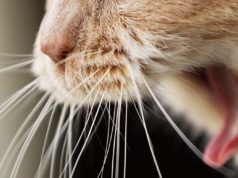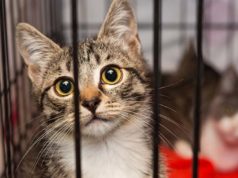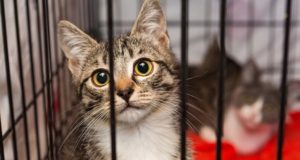No cat owner likes to see their pet poorly. It’s not as if they can tell us what they’re suffering from, so it’s up to us to find out what’s wrong with them. Not an easy task, but nonetheless, it is one of our responsibilities, as pet owners. Deciding when it’s time for a visit to the vet, usually means that we suspect their illness is more than we can handle.
More often than not, it turns out to be some tummy upset, a fighting wound, or something not too serious. We get home, fuss our moggy and breathe a sigh of relief. It’s those times though, when it turns out to be more serious, that we wished we’d gone to the vet sooner.
Given the seriousness of the Feline Leukemia Virus (FeLV), it pays to learn something in advance. If you can spot some of the common symptoms, it might just be enough to save your cat’s life. FeLV is passed on from cat to cat, and it can be fatal. Let’s have a look at some of the facts on this terrible illness. If we know what we’re looking for, it makes us more responsible and caring cat owners.
ALSO READ: 6 Facts About Feline Pancreatitis and What Pet Owners Must Know
13 Facts About Feline Leukemia Virus
1. Here are some of the symptoms of Feline Leukemia:
- Weight loss.
- Lack of appetite.
- Anaemic pale gums, dull coat.
- Poor, dull coat.
- Weakness, such as becoming unable to jump in places your cat has managed before.
- Poor teeth condition.
- Yellowed whites of the eyes.
2. A cat can catch feline leukemia from another infected cat, through body fluids, such as saliva, nasal fluids, feces and urine.
3. The virus develops in 6 stages:
- Once the bloodstream has become infected, the virus makes its way into the immune system, via the white blood cells. It begins to replicate, in the lymph nodes.
- The lymph nodes become infected, spreading the virus even further through the bloodstream.
- Immunosuppression takes place, as the virus attacks the cat’s immune system. This is a crucial stage in the development of the disease. If it fails to fight off the virus, it then leads to more complicated symptoms.
- In the later stages, bone marrow can become infected. When this happens, the cat will have FeLV for the rest of its life.
- From hereon the cat’s health deteriorates.
4. A cat may not necessarily contract the virus from an infected cat.
This is because the disease is not highly contagious. It takes constant contact, such as grooming, eating from the same bowl, sharing a litter tray, and even a bite from an infected cat. Kittens can be born with feline leukemia virus, having contracted it from the mother in womb.
5. FeLV is only harmful to cats, it is not transmitted to any other pet, or to humans.
6. FeLV can cause Lymphoma, cancer of the blood cells.
Feline leukemia virus is often a pathway to many other common diseases in cats.
7. Another serious effect of the virus, is that it weakens the immune system.
A cat with feline leukemia virus can become more susceptible to other viruses and infections. It will begin to suffer secondary infections, such as eye problems, as the defense mechanism weakens. Its digestive system could also become inflamed, leading to constant and chronic diarrhea. Prolonged infection can affect the nervous system, which could lead to seizures.
8. 30% of cats that contract feline leukemia will fight off the infection and survive.
These cats though will be prone to develop illnesses as they grow older. For cats that are persistently infected, the mortality rate is around 80-90%.
9. FeLV is diagnosed through blood tests, carried out by a veterinary expert.
Bloods go off to a lab, where they will look to see if excessive proteins are present. Such a test can also pick up the infection at its early stages.
10. A cats best chance of surviving FeLV, is to fight off the infection itself.
If it is unable to do this, there is no cure for the disease. There are ways to decrease the amount of the feline leukemia virus in the bloodstream. These can have serious side effects though, and are not suitable for all cats.
11. There are treatments for the secondary infections and illnesses that may occur, such as antibiotics.
This will help to keep the infected cat as healthy as possible, for its remaining lifespan. Secondary infections are often the cause of death, with their already weakened immune system.
12. If your cat is diagnosed positive, to prolong its life, it is imperative that he has regular check ups.
Make sure they are always clear of fleas and worms. Ideally, have them neutered, and then keep them indoors. Not only will this protect them from picking up other illnesses, but it will also stop them from spreading the disease.
13. There is a vaccination to help ensure your cat does not catch FeLV, but it is not 100% effective.
 Despite the injection, some cats will go on to catch feline leukemia. Before administrating the vaccine, cats are tested for feline leukemia. Only those who are free of the infection, should be vaccinated.
Despite the injection, some cats will go on to catch feline leukemia. Before administrating the vaccine, cats are tested for feline leukemia. Only those who are free of the infection, should be vaccinated.
Ideally, kittens should receive the vaccination at around 8 weeks of age. With a second injection 3-4 weeks later. Older cats should receive two doses, at around three or four weeks apart.
If you know or suspect your cat has not been regularly injected for feline Leukemia, be a responsible owner. Ask your vet about a course of vaccinations for your cat. Hopefully, it is not too late.
READ NEXT: How to Feed a Cat with Liver Disease














